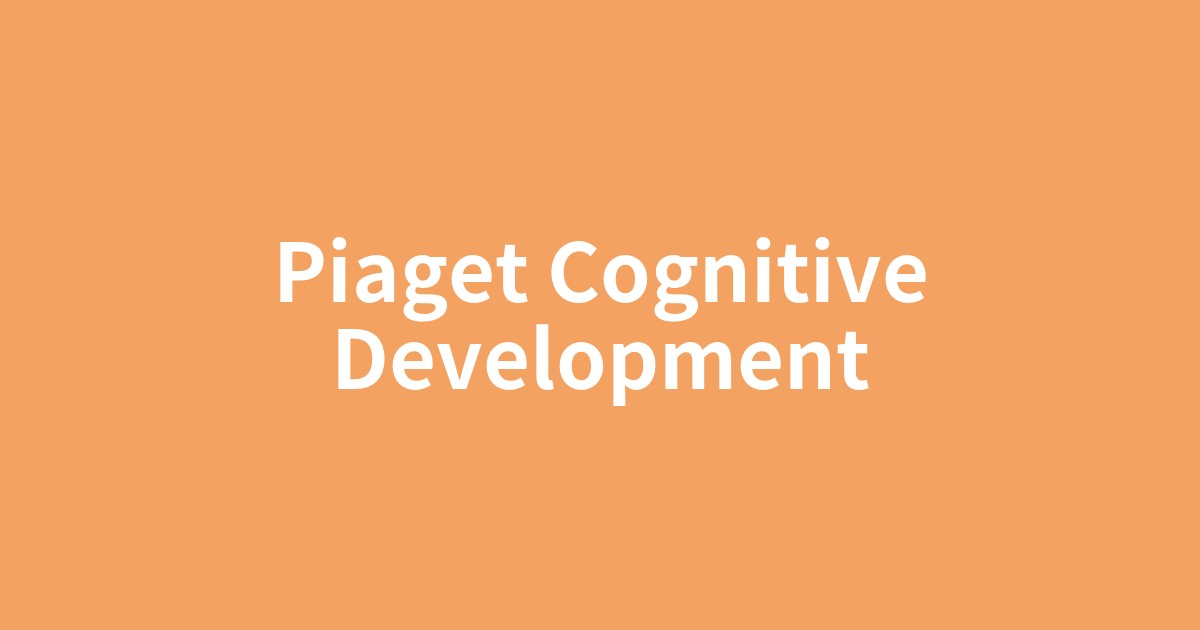このページは、歴史や文化の物語を楽しみながら、その文脈の中で重要な英単語を自然に学ぶための学習コンテンツです。各セクションの下にあるボタンで、いつでも日本語と英語を切り替えることができます。背景知識を日本語で学んだ後、英語の本文を読むことで、より深い理解と語彙力の向上を目指します。

子どもは「小さな大人」ではない。シェマの同化と調節を通して、子どもがどのように世界をconstruct(構築)し、思考を発達させていくか。
この記事で抑えるべきポイント
- ✓子どもは知識が不足している「小さな大人」ではなく、大人とは質的に異なる独自の思考様式を持つという、画期的な視点を提示したこと。
- ✓子どもは知識を受動的に受け取るのではなく、自らの経験を通して世界を解釈し、知識を能動的に「構築(construct)」していく存在であるという構成主義的な考え方。
- ✓世界を理解するための知識の枠組みである「シェマ(schema)」を、「同化(assimilation)」と「調節(accommodation)」という2つのプロセスを通じて絶えず更新していくこと。
- ✓認知発達は「感覚運動期」「前操作期」「具体的操作期」「形式的操作期」という、普遍的とされる4つの段階を経て進んでいくという段階説。
ピアジェと子どもの認知発達
子どもの不思議な言動を、単なる「間違い」や「未熟さ」で片付けてはいないでしょうか。この記事では、スイスの心理学者ジャン・ピアジェの理論を手がかりに、「子どもは自ら世界を構築する建築家である」という革命的な視点を探求します。子どもが決して「小さな大人」ではない理由を、一緒に見ていきましょう。
Piaget and Children's Cognitive Development
Do you ever dismiss a child's curious statements as simple mistakes or immaturity? This article explores a revolutionary perspective, guided by the theory of Swiss psychologist Jean Piaget: that a child is an architect who actively builds their own world. Let's discover together why children are by no means "little adults."
革命の始まり:子どもは「小さな大人」ではない
ピアジェが登場する以前、子どもはしばしば「小さな大人」と見なされていました。つまり、経験や知識が足りないだけで、大人と同じように物事を考えていると思われていたのです。しかし、ピアジェは自身の子供たちを注意深く観察する中で、その考えに強い疑問を抱きます。彼は、子どもたちの「間違い」にこそ、その発達段階に特有の思考様式、すなわち独自の「論理(logic)」が隠されていることを発見しました。例えば、同じ量のジュースを細長いコップに移し替えると「量が増えた」と答える子どもの姿は、大人の論理では説明できません。これは単なる間違いではなく、彼らの世界認識のあり方そのものを示していたのです。この発見が、彼の壮大な研究の出発点となりました。
The Beginning of a Revolution: Children Are Not "Little Adults"
Before Piaget, children were often regarded as "little adults"—individuals who thought just like grown-ups but simply lacked experience and knowledge. However, through careful observation of his own children, Piaget began to seriously question this view. He discovered that within children's "mistakes" lay a unique mode of thinking specific to their developmental stage—a logic of their own. For example, a child who insists that the amount of juice has increased when it's poured into a taller, thinner glass cannot be explained by adult logic. This wasn't just an error; it was a reflection of their very way of perceiving the world. This discovery became the starting point of his monumental research.
知の設計図:「シェマ」の同化と調節
ピアジェ理論の核となるのが「シェマ」という概念です。これは、私たちが世界を理解し、物事に対応するための知識の枠組みや行動のパターンのことです。子どもは、このシェマを生涯にわたって更新し続けます。そのプロセスには2つの重要な働きがあります。一つは「同化(assimilation)」です。これは、新しい情報や経験を、自分がすでに持っているシェマの枠組みに取り込んで理解しようとすることです。例えば、「犬」のシェマを持つ子どもが、初めて見るダックスフンドを「犬だ」と認識するのがこれにあたります。しかし、もし猫に出会ったらどうでしょう。犬のシェマではうまく説明できません。そこで起こるのが、もう一つの働きである「調節(accommodation)」です。これは、既存のシェマを修正したり、新しいシェマを作ったりして、新たな情報に対応するプロセスです。この「同化」と「調節」の絶え間ない繰り返しを通じて、子どもは知識を受動的に受け取るのではなく、自らの経験を通して能動的に知の世界を「構築する(construct)」のです。
The Blueprint of Knowledge: Schema, Assimilation, and Accommodation
At the core of Piaget's theory is the concept of a "schema"—a mental framework or pattern of action we use to understand the world and interact with it. Children continuously update this schema throughout their lives through two key processes. The first is assimilation. This is the process of incorporating new information or experiences into existing schemas. For instance, a child with a schema for "dog" recognizes a dachshund they've never seen before as a "dog." But what happens when they encounter a cat? The dog schema doesn't quite fit. This is where the second process, accommodation, comes in. This involves modifying an existing schema or creating a new one to cope with a new situation. Through this constant cycle of assimilation and accommodation, children do not passively receive knowledge; they actively construct their intellectual world through their own experiences.
思考が進化する4つのステップ:認知発達の段階
ピアジェは、子どもの「認知(cognition)」、つまり思考や知性がどのように変わっていくかについて、普遍的とされる4つの「段階(stage)」を提唱しました。この「発達(development)」の道のりは、誰もが同じ順序をたどると考えられています。第一段階は「感覚運動期」(0〜2歳頃)で、赤ちゃんは触ったりなめたりといった感覚と運動を通して世界を学びます。「ないないばあ」を喜ぶのは、目の前から消えたものが存在し続けるという認識がまだないためです。第二段階は「前操作期」(2〜7歳頃)で、言葉を話し始めますが、自己中心的な思考が特徴です。有名な「保存の概念」の実験、つまりコップの形を変えると水の量が変わったように見えてしまうのはこの時期です。第三段階「具体的操作期」(7〜11歳頃)になると、目の前にある具体的な物事については論理的な思考が可能になります。水の量の実験も、この段階でクリアできるようになります。そして最終段階が「形式的操作期」(11歳以降)で、抽象的な概念や仮説について考えたり、論理的な推論をしたりする力が身につきます。このように、思考は量的に増えるだけでなく、質的に大きく変化していくのです。
The Four Steps of Evolving Thought: The Stages of Cognitive Development
Piaget proposed that a child's cognition—their thinking and intelligence—progresses through four universal stages. He believed everyone follows this path of development in the same order. The first is the "Sensorimotor Stage" (approx. 0-2 years), where babies learn about the world through their senses and motor actions. Their delight in peek-a-boo stems from not yet understanding that objects continue to exist even when out of sight. The second is the "Preoperational Stage" (approx. 2-7 years), where language emerges, but thought is characterized by egocentrism. The famous conservation tasks—like failing to understand that the volume of water remains the same when its container changes shape—are typical of this period. In the third, the "Concrete Operational Stage" (approx. 7-11 years), logical thinking becomes possible for concrete, physical objects. Children can now pass the water conservation task. The final stage is the "Formal Operational Stage" (from age 11 onwards), where the ability to think about abstract concepts, form hypotheses, and engage in logical reasoning develops. Thus, thinking doesn't just increase quantitatively; it undergoes a profound qualitative transformation.
ピアジェ理論の現代的意義と批判
ピアジェが築いた理論は、児童心理学や教育学に計り知れない影響を与えましたが、決して絶対的なものではありません。後の研究によって、いくつかの批判や限界点も指摘されています。例えば、彼が提唱した発達段階の順序は普遍的だとされましたが、文化や教育環境によってその進み方には違いがあることが示唆されています。また、実験の課題設定によっては、ピアジェが考えていたよりも低い年齢の子どもが課題をクリアできることもあり、子どもの能力を過小評価していたのではないかという批判もあります。こうした批判的な視点を持つことで、私たちはピアジェの理論をより深く、多角的に理解することができるのです。
Piaget's Modern Significance and Criticisms
While Piaget's theory has had an immeasurable impact on child psychology and education, it is not without its flaws. Subsequent research has pointed out several criticisms and limitations. For example, although he proposed the sequence of developmental stages to be universal, studies suggest that cultural and educational backgrounds can influence the pace of this progression. Furthermore, some critics argue that Piaget may have underestimated children's abilities, as variations in experimental tasks have shown younger children succeeding at challenges they were thought incapable of. Adopting these critical perspectives allows us to understand Piaget's theory more deeply and from multiple angles.
結論:子どもという名の建築家たちへ
この記事を通じて、ジャン・ピアジェが提示した「子どもは世界を自ら構築する主体的な学習者である」という視点を探求してきました。子どもは知識の空白を埋めるだけの存在ではなく、独自の論理と方法で世界を解釈し、知の体系を築き上げていく小さな建築家なのです。この考え方は、生徒の主体性を重んじるアクティブ・ラーニングといった現代の教育思想にも深く根付いています。ピアジェの理論は、私たちに、子どもの「間違い」の奥にある豊かな思考の世界を想像し、その発達のプロセスを温かく見守ることの大切さを教えてくれます。今日から、あなたの子どもへの眼差しも、少し変わるかもしれません。
Conclusion: To the Architects We Call Children
Throughout this article, we have explored the perspective Jean Piaget presented: that a child is an active learner who constructs their own understanding of the world. Children are not empty vessels to be filled with knowledge but rather little architects who interpret the world with their own logic and build their own systems of knowledge. This idea is deeply embedded in modern educational philosophies like active learning, which emphasizes student autonomy. Piaget's theory teaches us the importance of imagining the rich world of thought behind a child's "mistakes" and of warmly observing their developmental process. Perhaps, starting today, the way you look at children will change, just a little.
テーマを理解する重要単語
logic
この記事では、大人の「論理」と、子どもが持つ独自の「論理」が対比されています。子どもたちの「間違い」が、実はその発達段階に特有の思考様式、つまり一貫した内的世界観に基づいていることを示す重要な概念です。この単語に着目することで、子どもの視点を深く理解できます。
文脈での用例:
There is a certain logic to his argument, even if you don't agree with it.
たとえ同意できなくても、彼の議論には一定の論理があります。
perceive
「知覚する、理解する」を意味し、子どもが世界をどのように認識し、解釈しているかという記事の核心に触れる動詞です。ジュースの量の例で示されるように、子どもと大人では世界の「perceive」の仕方が質的に異なる、というピアジェの発見を理解する上で欠かせない単語です。
文脈での用例:
We perceive the world through our five senses.
私たちは五感を通して世界を知覚する。
stage
この記事では、ピアジェが提唱した認知発達の4つの「段階」を指すキーワードとして使われています。思考が量的に増えるだけでなく、質的に変化していく普遍的なプロセスを説明する上で不可欠な概念です。各「stage」の特徴を理解することが、ピアジェ理論の全体像を把握することに繋がります。
文脈での用例:
The project is in its final stage.
そのプロジェクトは最終段階にあります。
cognitive
記事全体のテーマ「認知発達(cognitive development)」を構成する中心語です。単に「知的な」と訳すだけでなく、「知識を獲得し、理解し、思考する精神的なプロセス全般」を指す言葉だと理解することが、ピアジェの理論の核心を掴む鍵となります。この記事を読む上で最も重要な単語の一つです。
文脈での用例:
As we age, some cognitive abilities may decline.
年を取るにつれて、いくつかの認知能力は低下するかもしれない。
abstract
ピアジェの発達段階の最終段階「形式的操作期」を特徴づける重要な単語です。目に見えない「抽象的な」概念や仮説について論理的に思考する能力を指します。具体的な物事に思考が縛られる「具体的操作期」との質的な違いを際立たせ、思考の成熟を描写する上で欠かせません。
文脈での用例:
Justice and beauty are abstract concepts.
正義や美は抽象的な概念です。
construct
「構築する」という意味のこの動詞は、この記事の結論「子どもは自ら世界を構築する建築家である」という比喩を支える核心的な単語です。子どもが知識を受動的に受け取るのではなく、自らの経験を通して能動的に知の世界を「築き上げる」という、ピアジェ理論の主体的な学習者観を象徴しています。
文脈での用例:
Gender is considered by many to be a social construct.
ジェンダーは多くの人によって社会的な構築物であると考えられている。
autonomy
記事の結論部分で、ピアジェの理論が現代の教育思想「アクティブ・ラーニング」に与えた影響を説明する際に登場します。生徒の「自主性」を重んじるという考え方が、子どもを主体的な学習者と見なすピアジェの思想と深く結びついていることを示し、理論の現代的意義を理解する鍵となります。
文脈での用例:
The university has a high degree of autonomy from government control.
その大学は政府の管理から高度に自律している。
criticism
ピアジェ理論を絶対的なものとしてではなく、多角的に理解するために重要な単語です。この記事では、理論の限界点や後の研究による「批判」にも触れることで、読者に科学的な思考態度を促しています。偉大な理論も検証と「criticism」を経て発展するという、学問の本質を示唆しています。
文脈での用例:
The new policy has faced sharp criticism from the opposition.
その新しい政策は野党から厳しい批判に直面した。
accommodation
「宿泊施設」という意味が有名ですが、この記事ではピアジェ理論における「調節」という専門用語として使われます。既存のシェマでは対応できない新しい情報に対し、シェマ自体を修正したり新しく作ったりする過程を指します。「同化」とこの「調節」のサイクルが、認知発達の原動力です。
文脈での用例:
The hotel provides accommodation for up to 100 guests.
そのホテルは最大100人までの宿泊施設を提供しています。
assimilation
ピアジェ理論の重要概念で、「同化」と訳されます。新しい情報や経験を、自分が既に持っている「シェマ(知識の枠組み)」に取り込んで理解しようとする働きのことです。対になる「調節(accommodation)」とセットで覚えることで、子どもが能動的に知識を構築するプロセスが明確になります。
文脈での用例:
The cultural assimilation of immigrants into the new society took several generations.
移民が新しい社会へ文化的に同化するには数世代かかった。
revolutionary
「子どもは小さな大人ではない」というピアジェの視点が、当時の常識を覆すほど「画期的」であったことを示すために使われています。この単語は、ピアジェの理論が単なる新しいアイデアではなく、児童心理学におけるパラダイムシフトであったという、この記事のメッセージの強度を伝えています。
文脈での用例:
The invention of the internet was a revolutionary development in communication.
インターネットの発明は、コミュニケーションにおける革命的な発展でした。
schema
ピアジェ理論の核となる専門用語です。私たちが世界を理解するための「知識の枠組み」や「思考のパターン」を指します。この記事では、子どもが「同化」と「調節」を通じてこのシェマを更新していく過程が描かれており、この概念の理解なくしてピアジェ理論の読解は不可能です。
文脈での用例:
He developed a schema for organizing his research data.
彼は研究データを整理するためのスキーマを開発した。